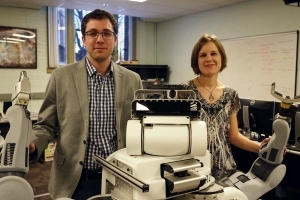
Dmitry Berenson, left, and Sonia Chernova with a PR2 personal robot. (Worcester Polytechnic Institute)
3 February 2014. Computer scientists at Worcester Polytechnic Institute in Massachusetts are researching interactions between humans and robots in factory and home settings, working either as collaborators with or helpers to people. Research by Worcester Tech faculty Dmitry Berenson and Sonia Chernova, is funded by a pair of three-year grants from National Science Foundation’s National Robotics Initiative, totaling $1.25 million.
Berenson, with colleagues from Massachusetts Institute of Technology, aims to get a better understanding of ways robots and humans can interact in small manufacturing operations. That understanding includes better defining and optimizing the work to be performed, and improving the process for conducting the work. Task definition and optimization are the responsibility of participants from MIT, while Berenson and Worcester Tech colleagues focus on improving production processes with robots as collaborators.
A big part of the Berenson’s work involves safety. “In any manufacturing operation, there is a tradeoff between speed and efficiency on the one hand, and safety on the other,” says Berenson in a university statement. “This is especially true when you add a robot to the mix. By helping robots understand how people move and do things, we can help them enhance productivity without being a hindrance or safety risk.”
Teams at Worcester Tech and MIT plan to enlist volunteers to conduct assembly tasks like those performed in manufacturing, which will be recorded by cameras and laser scanners into a library of human task behaviors. These behaviors then will be integrated with algorithms that help guide the robots’ motions, as they work alongside their human counterparts. Berenson and colleagues then expect to put robot and human volunteers in the same room to perform assembly tasks, while measuring productivity and getting feedback from humans on their comfort working with robotic colleagues.
Chernov’s project, with colleagues at Georgia Institute of Technology, is looking into the ability of humans to train robots to perform tasks aimed at helping humans in their homes, for example people with disabilities. The Worcester Tech/Georgia Tech team plans to enlist citizen-scientists to train robots to perform simple household tasks, which are familiar to many people and with multiple steps, as well as having no single correct method for accomplishing them.
This study starts with collecting basic robotic movements and functions, such as grasping objects and moving them from one place to another, then linking these movements and functions together into complete tasks. Chernov notes that building tasks in this way is different from motion learning, where robots perform precise, repeatable movements like those in a factory “It differs from motion-controlled learning, where you literally move the robot to show it what you want it to do,” she says in a university statement. “But if you are going to teach a robot to clean your kitchen, you don’t want to do so at that level.”
To enlist a wide range of diverse volunteers to train robots, Chernov and colleagues built a Web-based lab known as RobotsFor.Me, where volunteers interact with both simulated and actual robots. The researchers hope to attract hundreds of volunteers, who will train robots in tasks such as folding laundry and setting the table. The team will then synthesize the different methods of teaching into various models that they hope will enable robots to adapt to different teaching styles.
Building in this kind of adaptability will be important, since trainable robots are likely to encounter multiple teachers, some of whom may try to train the robot in tasks the robot already mastered, but using a different approach. “[H]ow can a teacher find out what a robot knows? Chernov asks. “And how can a robot communicate to a teacher that it is confused? These are the kinds of questions we hope to answer through this research.”
Read more:
- Computer Learning Process Developed for Robotic Arm Movement
- U.K. University to Build Advanced Manufacturing Facility
- FDA Approves Robotic Device for Stroke Rehabilitation
- Low Cost Soft-Touch Robotic Sensor Circuits Commercialized
- Robotics Cloud Software Platform Being Demonstrated
* * *

 RSS - Posts
RSS - Posts
You must be logged in to post a comment.